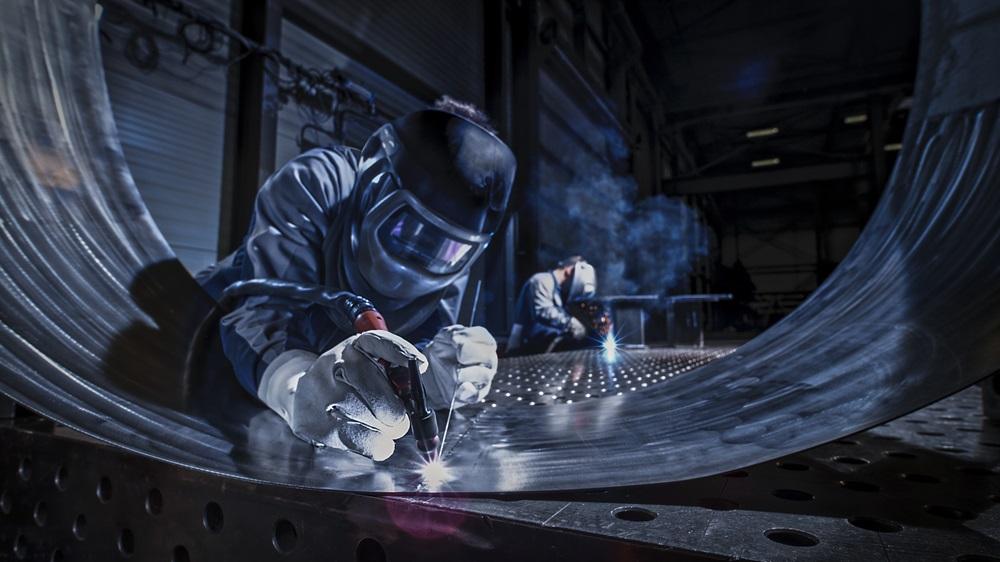Jobs
How advancements in welding helmet technology help keep jobs moving

Editor’s Note: This article was originally published in the March 2024 issue of Canadian Fabricating & Welding.
Welding helmet designs are constantly being tweaked to improve comfort and functionality. The digital sophistication of these important safety tools also is increasing with every new iteration.
The following details five welding helmets and how they address a variety of welder needs.
Carrying Comfort
Fronius’ Vizor Crystal Air 3X helmet automatically adjusts the level of protection within shades 5 to 13 to match the welding process. It has a 1/1/1/1 EN 379 rating for optical class, scattered light, homogeneity, and viewing angle dependency.
With its Bluetooth autodarkening sensor, the helmet automatically darkens the screen when the trigger on the welding torch is pressed. This adds a level of protection for the welder by preventing any initial spark from hitting the eye.
The helmet is designed to be suitable for overhead applications due to its smoke- and particulate-repellant design.
The helmet pairs with the company’s Vizor Air/3 or Air/3X powered air-purifying respirator (PAPR) system.
“Key to any filtration system is that it be effective, have a battery system that is long lasting enough to get you through an eight-hour shift, and be lightweight and portable enough that it isn’t getting in the way of you doing your job,” said Jordan Dean, welding application technologist, Fronius Canada.
“A filtration unit will require you to change filters periodically, but the frequency of that will depend on the environment in which you work. Our system includes a built-in sensor that monitors constant airflow volume,” Dean explained. “Systems can be adjusted for airflow rates of 150, 200, or 250 liters/min., depending on your requirements for the job. If you fall below your set rate, the system lets you know, and you can switch out your filter. It will also detect if the filter is missing and switch off the system.”
Airflow in the helmet can also be adjusted to send more or less airflow to the top or bottom of the helmet.
The PAPR system is lightweight but can also be adjusted for comfort.
“It can be configured to sit on your waist as a belt, or you can use our four-point harness to put it on your back like a backpack to distribute the weight more evenly on your body,” said Dean.
Dean noted that the company’s helmet design has been improved for comfort, with more points of contact to create a more comfortable fit with better weight distribution.
The PAPR system has the option of a 10- or 20-hour battery life.
Airflow Ideals
Messer’s ClearVIEW PA800 is a respiratory protective system based on the principle of circulated positive-pressured air in the hood. The belt-mounted blower unit delivers air through a filter and via an air hose into a headpiece (a hood or mask). The supply of filtered air creates positive pressure inside of the headpiece, which prevents the external contaminated air from entering the user’s breathing zone. It also includes a disposable high-efficiency particle filter system. The system is certified for use with the OHE410 digital ADF helmet, which covers head sizes from 535 to 600 mm circumference.
The high-efficiency TH2 PRSL filter allows the system to protect against hazards such as powders, mists, and welding fumes. It has an assigned protection factor of AP20.
The unit contains a removable, eight-hour, rechargeable lithium-ion battery, allowing it to be used for split shifts with a simple battery change.
Constructed from robust ABS material, the system can withstand harsh welding environments. It also comes with a spark deflector designed to protect the PRSL filter from direct contact with spatter or airborne particles.
The OHE410 welding helmet is fitted with a cotton FR-treated face seal to maximize comfort and features a multi-adjustable headgear with an overhead air duct and a fluted air diffuser to reduce the risk of “dry eye effect” by directing the air flow towards the front of the shell and not over the user’s eyes.
The headtop is equipped with a digital electronic ADF with grind function in shades 3, 5 through 8, and 9 through 13. Switching time from clear to dark is approximately 0.00004 seconds (0.04 ms). The ADF provides complete UV and IR light protection in both dark and clear states and is powered by a lithium battery. The welding filters operate well under extreme low lighting and very strong sunlight by adjusting the sensitivity of the lens.
The unit includes a bag with three outer lenses, two inner lenses, and a five-pack of prefilters.
A Better View
ESAB’s Sentinel A60 offers a 40% larger viewing area than its A50 model. The viewing area measures 4.65 in. by 2.80 in., and it has an optical quality rating of 1/1/1/1 for a distortion-free view. The company’s new OpTCS broad-spectrum light control technology and True Color view provide a clearer distinction between the arc, the weld puddle, and heat-affected zone.
The helmet also adjusts the shade level in half-point increments from shade 5 to 13. A total of 18 different shade levels cover every shade needed for welding and cutting, from oxyfuel and plasma cutting to low-amperage TIG and high-amperage welding with large electrodes. An external Grind Mode button maintains a passive shade of 3 for fit-up or grinding, eliminating the need to lift the hood or switch it out for a grinding shield. Four arc detection sensors provide a switching time of 0.8 ms, so an operator will never be caught off guard by a co-worker’s arc or when welding out of position. The Shade Lock feature allows the ADF to remain in the darkened state while activated.
“Sentinel A60 combines a superior optical experience with productivity-enhancing benefits,” said Kevin Beckerdite, global product manager, PPE, ESAB. “The wider view creates more spatial awareness prior to welding. The superior optics help welders keep the weld puddle centered in the joint, keep the electrode on the leading edge of the puddle, position a cutting torch more accurately, and do it all while reducing eye fatigue.”
The helmet is designed with ESAB’s signature rounded low-profile shell for better clearance in tight areas and more protection from light and sparks. It includes a five-contact-point Halo headgear, which better distributes helmet weight and offers hundreds of thousands of fit adjustments. At 1.4 lbs., the helmet weighs just 1/7 oz. more than the previous model, an impressive engineering feat because the ADF cartridge is the heaviest item on a helmet.
Internal warning lights alert the operator of grind mode, low battery, and ADF shade lock. It comes with two replaceable CR 2450 lithium batteries with solar backup, and a large outer protective lens is available in high-contrast clear and amber tints.
Clarity and Connectivity
The new VIKING 3350ADV series welding helmet from Lincoln Electric takes the company’s autodarkening helmet series to a new level, pairing the 4C Optics and X6 Headgear—featuring advanced digital controls, modular workpiece illumination, auto-shade technology, and Bluetooth connectivity.
The 4C lens technology is the company’s proprietary LCD that enhances the visible color spectrum of the display, which broadens the color range and hues in both light and dark states. This eliminates imperfections and color saturation to create the clearest view of the base material, arc, and puddle while reducing eye strain.
The helmet has 1/1/1/1 optical clarity that eliminates distortion, removes blurriness, and provides uniform and consistent shade at all angles. It has variable shade range of 5 through 13 and low-profile external grind controls with three memory slots to save commonly used settings.
The digital user interface features four dedicated helmet modes (weld, cut, grind, and auto), innovative auto shade technology that continuously monitors the environment and automatically adjusts the lens shade, and an intuitive digital display that provides advance control and navigation of helmet settings.
It connects via Bluetooth to the GearPoint App, which tracks productivity, predictive maintenance, welder resources, and control settings.
The X6 headgear features an adjustable top head support, rotatable front headband, strategically positioned rear headband, an orientation adjustment pin, and forward and backward adjustments to distribute weight, reduce pressure, and optimize balance.
The helmet’s modular LED light improves visibility during arc-off time, while maintaining a low profile that’s easily integrated into the shade cartridge. The viewing area is 11.8 sq. in., providing a large field of view to increase versatility and operator control.
The helmet is hard hat and cheater lens compatible and provides enhanced outdoor performance.
Digital Support
Miller Electric Mfg.’s Digital Infinity helmet features critical technological advances to provide ease of use and valuable data to the user.
The helmet includes the company’s ClearLight 2.0 lens technology, which provides advanced high-definition optics for a clear, bright, and realistic view before, during, and after every weld. According to the company, this lens technology provides two times better visibility versus the leading 1/1/1/1 lens benchmark according to ANSI tests.
It allows for a 3.0 light state, which is brighter and allows operators to keep their hood down, improving safety and productivity.
The helmet has a 13.4-sq.-in. viewing area.
Sensing and reporting technologies add to the helmet’s functionality. For instance, InfoTrack 2.0 monitors arc time and arc count for quoting and metrics. The company’s AutoSense technology automatically sets the helmet sensitivity by sensing the welding environment. This is suitable for weld operators who frequently adjust their settings for changing welding environments.
The helmet also includes four independent arc sensors to provide better lens response for obstructed or low-amp welding. Its X-Mode also electromagnetically senses the weld to eliminate sunlight interference and continuously detects the arc even if sensors are blocked. With its auto on/off function, the lens automatically turns on at the strike of an arc. Half-shade settings, meanwhile, are available for precise shade adjustments.










